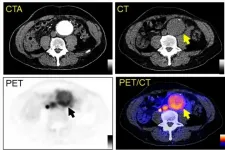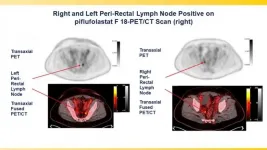Lead author Dr Alessandra Borsini, NIHR Maudsley BRC Senior Postdoctoral Neuroscientist at King's College London, said: "Using a combination of laboratory and patient research our study has provided exciting new insight into how omega-3 fatty acids bring about anti-inflammatory effects that improve depression. For some time we have known that omega-3 PUFA can induce anti-depressant and anti-inflammatory effects but, without further understanding of how this happens in the human brain, it has been difficult to develop treatments. Our study has helped shine a light on the molecular mechanisms involved in this relationship which can inform the development of potential new treatments for depression using omega-3 PUFA."
Previous research has shown that people with major depressive disorder have higher levels of inflammation in their bodies than those without the disorder. There are currently no proven anti-inflammatory treatment strategies for depression and, although two important omega-3 PUFAs, EPA and DHA, have been shown to provide anti-inflammatory and antidepressant effects, the precise mechanism by which they do this is unknown.
Depression in a dish The study set out to test the theory that when omega-3 fatty acids are utilised and processed in the body, some of their metabolites (known as lipid mediators) are able to protect the brain from the harmful effects of inflammation. Researchers used a validated in vitro human cell model known as 'depression in a dish' that was developed at the NIHR Maudsley Biomedical Research Centre and which uses cells from the hippocampus, a part of the brain fundamental in many cognitive, memory and learning areas thought to be important in depression. Hippocampal cells play an important role in the production of new neurones - neurogenesis.
The study showed that treating human hippocampal cells with EPA or DHA before being exposed to chemical messengers involved in inflammation called cytokines, prevented increased cell death and decreased neurogenesis. Both these impacts had been previously observed in cells exposed to cytokines alone. Further investigation confirmed these effects were mediated by the formation of several key lipid mediators produced by EPA and DHA, namely hydroxyeicosapentaenoic acid (HEPE), hydroxydocosahexaenoic acid (HDHA), epoxyeicosatetraenoic acid (EpETE) and epoxydocosapentaenoic acid (EpDPA), and these were detected for the first time in human hippocampal neurones. Further investigation showed that treatment with an enzyme inhibitor increased the availability of two of these metabolites (EpETE and EpDPA) suggesting a possible way by which future treatments could be optimised.
Professor Anna Nicolaou, professor of Biological Chemistry at the Faculty of Medical and Human Sciences, The University of Manchester, who led the team that measured the lipid mediators using mass spectrometry said: "The lipid mediators that our research identified are broken down in the body relatively quickly, which means they may only be available for a relatively short time. By testing the effect of inhibitors of the enzymes involved in the metabolism of omega-3 PUFA we showed that we can greatly improve how long they can have an effect in the body and ultimately, increase their efficacy. This is very important for the development of new treatments and means that patients could be given higher doses of EPA and DHA together with these enzyme inhibitors to increase the amount of these important compounds in their blood over time."
Omega-3 metabolites in patients The study assessed twenty-two patients with major depression who were given either 3 grams of EPA or 1.4 grams of DHA daily for twelve weeks. The lipid metabolites of EPA and DHA were measured in their blood before and after the omega-3 PUFA treatment, along with a score of their depressive symptoms. In both groups of patients, EPA or DHA treatment was associated with an increase in their respective metabolites and a significant improvement in depressive symptoms - an average reduction in symptom scores of 64% and 71% in the EPA and DHA groups respectively. In addition, higher levels of the same metabolites identified in the in vitro experiments were correlated with lower levels of depressive symptoms.
The levels of EPA and DHA used in this study are concentrations that most likely cannot be achieved with dietary consumption of oily fish, a rich source of omega-3 PUFAs, but require therapeutic supplements.
Future Research The results of the study indicate that the bioactive lipid mediators produced by the breakdown of EPA and DHA in the body could be targeted as a mechanism to reduce depression and inflammation but there is a need to ensure that their effects are prolonged in order for this approach to be successful. Previous research indicates a key enzyme in the omega-3 fatty acid metabolism could be a valid option for drug repurposing and could be used for other inflammation-associated brain disorders, including depression, where at least a sub-group of patients often have chronic levels of inflammation.
Senior author of the paper, Professor Carmine Pariante, NIHR Maudsley BRC Affective Disorders Interface with Medicine Theme Lead said: "There is ever growing interest in the links between the immune system, inflammation and depression but in order to develop new treatments in this area we need to better understand the mechanisms behind these relationships. Our study has provided important insight into how known anti-inflammatory compounds - the omega-3 PUFA - help reduce depression. By identifying and measuring the exact lipid mediators that are involved, identifying the enzyme that prolongs their effects and finding the same lipid mediators in depressed patients treated with omega-3 PUFA and demonstrating improvements in symptoms, we have provided vital information to help shape clinical trials for future therapeutic approaches with omega-3 fatty acids.
"It is important to highlight that our research has not shown that by simply increasing omega-3 fatty acids in our diets or through taking nutritional supplements we can reduce inflammation or depression. The mechanisms behind the associations between depression and omega-3 PUFA are complicated and require further research and clinical trials to fully understand how they work and inform future therapeutic approaches."
The study was a collaboration between researchers from King's College London, The University of Manchester and China Medical University.
The paper Omega-3 polyunsaturated fatty acids protect against inflammation through production of LOX and CYP450 lipid mediators: relevance for major depression and for human hippocampal neurogenesis was published today (Wednesday 16 June) in Molecular Psychiatry.
INFORMATION:
Notes to Editors
For more information and for a copy of the paper under strict embargo until 01:00 am Wednesday 16 June 2021 please contact: Franca Davenport, Communications and Engagement Manager, NIHR Maudsley Biomedical Research Centre, franca.davenport@kcl.ac.uk or Serena Rianjongdee, Communications and Engagement Officer, NIHR Maudsley Biomedical Research Centre, serena.rianjongdee@kcl.ac.uk
The paper will be available after the embargo lifts on: https://www.nature.com/articles/s41380-021-01160-8
The labels have been added to this press release as part of a project run by the Academy of Medical Sciences seeking to improve the communication of evidence. For more information, please see: http://www.sciencemediacentre.org/wp-content/uploads/2018/01/AMS-press-release-labelling-system-GUIDANCE.pdf if
About King's College London and the Institute of Psychiatry, Psychology & Neuroscience
King's College London is one of the top 10 UK universities in the world (QS World University Rankings, 2020) and among the oldest in England. King's has more than 31,000 students (including more than 12,800 postgraduates) from some 150 countries worldwide, and some 8,500 staff.
The Institute of Psychiatry, Psychology & Neuroscience (IoPPN) at King's College London is the premier centre for mental health and related neurosciences research in Europe. It produces more highly cited outputs (top 1% citations) on mental health than any other centre (SciVal 2019) and on this metric we have risen from 16th (2014) to 4th (2019) in the world for highly cited neuroscience outputs. World-leading research from the IoPPN has made, and continues to make, an impact on how we understand, prevent and treat mental illness and other conditions that affect the brain.
http://www.kcl.ac.uk/ioppn @KingsIoPPN
The National Institute for Health Research (NIHR)
The mission of the National Institute for Health Research (NIHR) is to improve the health and wealth of the nation through research. We do this by:
Funding high quality, timely research that benefits the NHS, public health and social care;
Investing in world-class expertise, facilities and a skilled delivery workforce to translate discoveries into improved treatments and services;
Partnering with patients, service users, carers and communities, improving the relevance, quality and impact of our research;
Attracting, training and supporting the best researchers to tackle complex health and social care challenges;
Collaborating with other public funders, charities and industry to help shape a cohesive and globally competitive research system;
Funding applied global health research and training to meet the needs of the poorest people in low and middle income countries.
NIHR is funded by the Department of Health and Social Care. Its work in low and middle income countries is principally funded through UK Aid from the UK government.
About the University of Manchester
The University of Manchester, a member of the prestigious Russell Group, is one of the UK's largest single-site university with more than 40,000 students - including more than 10,000 from overseas. It is consistently ranked among the world's elite for graduate employability. The University is also one of the country's major research institutions, rated fifth in the UK in terms of 'research power' (REF 2014). World-class research is carried out across a diverse range of fields including cancer, advanced materials, global inequalities, energy and industrial biotechnology.




